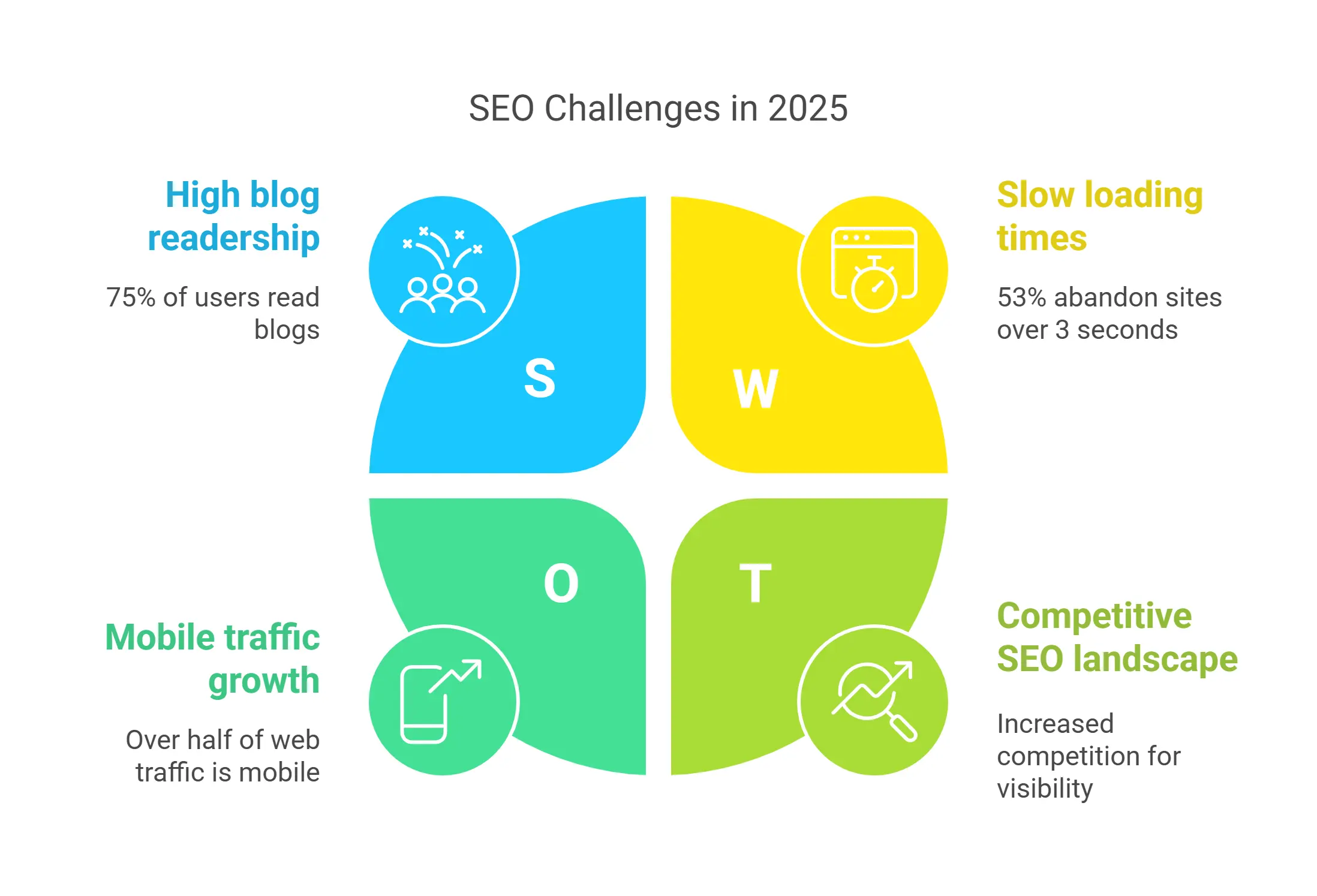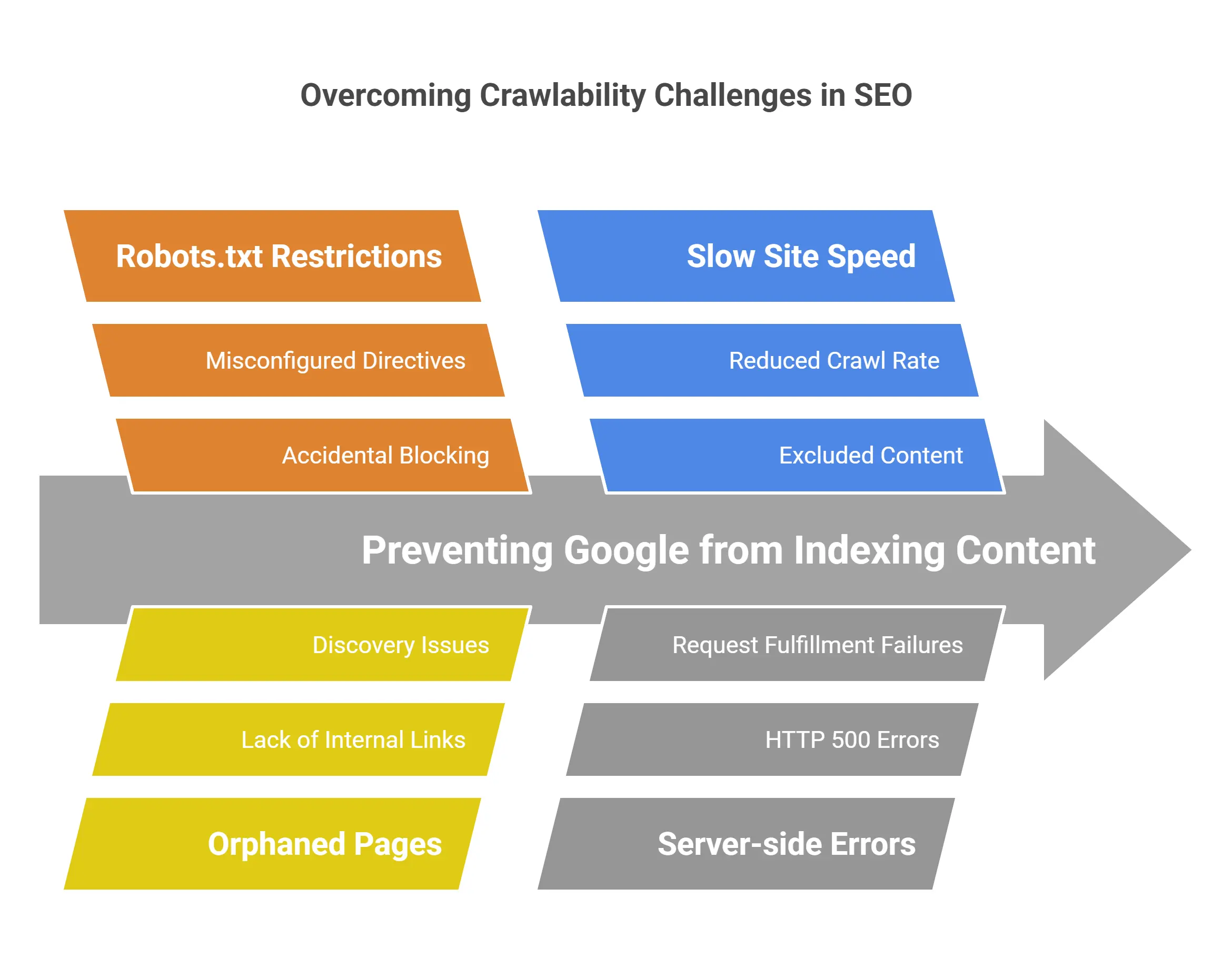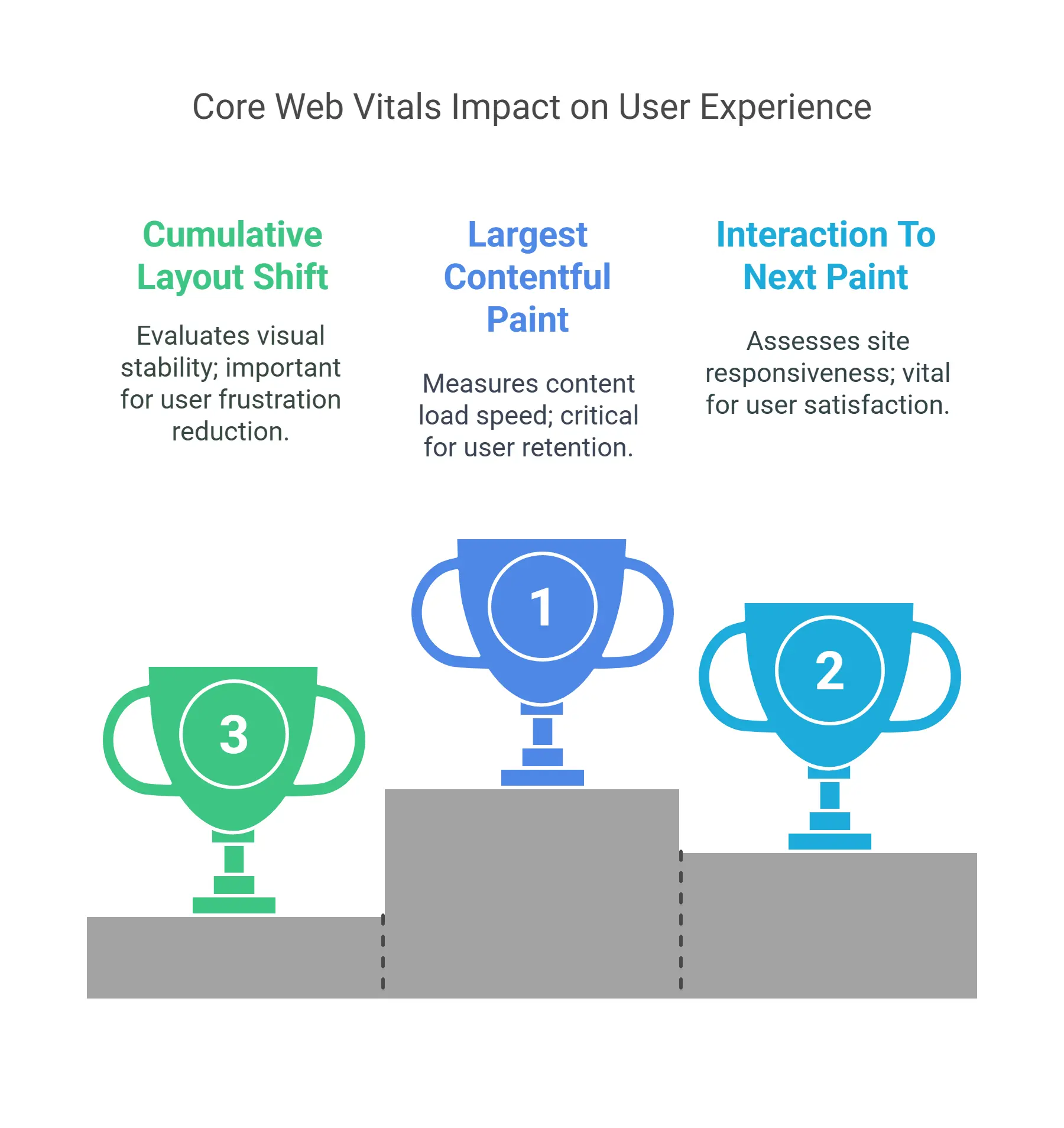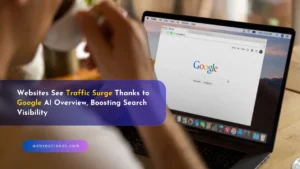SEO mistakes are costing you more than ever in 2025, with 53% of visitors abandoning websites that take longer than 3 seconds to load. In fact, the SEO landscape has become increasingly competitive, making it crucial to identify and fix these traffic-killing errors before they damage your rankings. While 75% of internet users still actively read blogs, many businesses struggle to capture this massive audience due to common SEO mistakes that slip under their radar.
As search engines become more sophisticated, they prioritize content that truly serves user intent rather than simply matching keywords. Your website’s success depends on avoiding these biggest SEO mistakes, especially since more than half of global web traffic now comes from mobile devices. Whether you’re running an e-commerce store, a SaaS company, or a local business, understanding these hidden pitfalls is essential for maintaining and growing your online presence in 2025.

Data Reveals How Image Optimization Neglect Costs 8% Traffic
Recent data analysis reveals that neglecting image optimization costs businesses an average of 8% in potential organic traffic. As visual content becomes increasingly central to digital marketing strategies, poorly optimized images have emerged as a silent traffic killer for websites across industries.
Why Google Penalizes Poor Image Practices in 2025
Google has been using loading speed as a ranking factor since 2010, but its algorithms have grown significantly more sophisticated in evaluating image quality and relevance. The search engine now actively penalizes websites with poor image practices through both algorithmic and manual penalties that directly impact your search visibility.
When your site receives a Google penalty for image-related issues, it becomes less visible or completely invisible to your target audience, resulting in severe traffic drops. These penalties ensure Google maintains useful and relevant search results for its users.
The penalties affect websites in several ways:
- Slow loading times: Unoptimized image files significantly reduce page speed, triggering Google’s performance-based penalties
- Mobile experience issues: With Google’s switch to mobile-first indexing in 2020, non-mobile-friendly websites with poorly optimized images face additional penalties
- Content relevance signals: Improper image tagging, missing alt text, and irrelevant images confuse search engines about your content’s purpose
Furthermore, Google can detect when structured data around images is irrelevant to the content, possibly resulting in manual penalties. Additionally, as search becomes increasingly multimodal, companies that neglect visual content optimization risk losing visibility and relevance.
Technical SEO Errors Silently Damage Your Rankings
Behind the scenes of your website, technical SEO issues silently erode your rankings without any obvious warning signs. Unlike content problems that you can visually identify, these backend errors often go undetected until significant traffic loss has already occurred.
How Crawlability Issues Prevent Google from Indexing Your Best Content
Crawlability problems prevent search engines from accessing your website’s pages, making them essentially invisible in search results. If Google can’t find your pages, they can’t index them—meaning they won’t appear in relevant search results, resulting in lost organic traffic and conversions.

Several critical issues commonly block proper crawling:
- Robots.txt restrictions: Search engines first check this file to determine which pages they should crawl. A single mistake could accidentally block your entire website with a directive like
User-agent: * Disallow: / - Orphaned pages: Pages without internal links pointing to them create major crawlability problems as search engines struggle to discover them
- Slow site speed: Pages that load slowly reduce the number of pages bots can crawl in a single session, potentially excluding important content
- Server-side errors: HTTP status codes like 500 errors disrupt the crawling process when the server can’t fulfill the request
- Redirect loops: These prevent search engine bots from reaching the final destination by trapping them in endless cycles between pages
Notably, mobile-first indexing has further complicated crawlability. Since Google now primarily uses the mobile version of your site for crawling and indexing, sites with poor mobile performance face additional penalties. Consequently, businesses with older sites frequently encounter these issues, as approximately half of websites appeared in search results through mobile-first indexing as of December 2018.
Schema Markup Mistakes That Make You Invisible in Rich Results
Schema markup errors prevent your content from appearing in rich results, significantly reducing your visibility in search. Furthermore, these errors can trigger manual actions from Google, causing your structured data to be completely ignored.
Common schema markup mistakes include:
- Marking up invisible content: Adding schema for elements users can’t see on the page (such as hidden reviews) may be considered deceptive by Google and lead to penalties
- Applying page-specific markup sitewide: For instance, using one hotel property’s ratings across all properties
- Using incorrect structured data: According to Schema App data, many businesses fail to include required properties in their Product markup, rendering them ineligible for rich results
- Failing to monitor schema performance: Not tracking schema effectiveness through Google Search Console means you’ll miss errors that make your content ineligible for rich results
- Insufficient semantic connections: Modern search engines prioritize content with clear semantic relationships. Not connecting entities in your schema markup (like linking your Brand to your Product) diminishes your visibility in increasingly conversational search experiences
Ultimately, technical SEO errors damage your rankings by creating disconnects between your content and search engines. These mistakes primarily impact your site in two ways: preventing discovery of your pages through crawling issues, and reducing visibility through schema markup errors. Addressing these issues isn’t just about fixing errors—it’s about creating pathways for search engines to properly understand and showcase your best content.
Small Businesses Lose Local Customers Through These Mapping Mistakes
Local mapping errors cost small businesses up to 40% of potential customers, with many entrepreneurs unaware that their online location data is working against them. Unlike more obvious seo mistakes, mapping errors silently redirect customers to competitors or lead them on frustrating wild goose chases.
Google Business Profile Errors That Misdirect Your Customers
The most damaging local seo mistake is creating a Google Business Profile (GBP) and then forgetting about it. Approximately 80% of consumers use local searches to find nearby businesses, yet many companies leave money, traffic, and leads on the table by neglecting their GBP.
Your profile serves as your digital storefront – when outdated or incomplete, both customers and Google assume your business isn’t active or reliable. Critical errors include:
- Outdated operating hours leading customers to arrive when you’re closed
- Missing services or products that prevent Google from showing your business for relevant searches
- Lack of recent photos giving the impression of an inactive business
- Not responding to reviews, which Google actively rewards in rankings
Even worse than an incomplete profile is not claiming it at all – “if Google doesn’t know you exist, neither do your customers”. Google prioritizes businesses with higher review scores and more positive ratings in local search results, making review management essential for visibility.
How Inconsistent NAP Data Confuses Search Engines
Name, Address, and Phone number (NAP) consistency refers to these details remaining identical across all online citations. Something seemingly minor like a missing digit in your zip code can spiral into significant ranking problems.
Google requires consistent data to verify your business’s legitimacy. When search engines detect variations (like “Smith & Co. Plumbing” versus “Smith and Company Plumbing”), they struggle to determine which listing is correct. Consequently:
- Your local search rankings drop dramatically
- Voice search visibility diminishes, with 80% of voice search results coming from top three positions
- Consumer trust erodes, as 93% of people report frustration with incorrect directory information
- 80% of consumers lose trust entirely when finding inconsistent contact details
These inconsistencies confuse both algorithms and real customers, who hold businesses responsible for directory errors. The resulting traffic loss directly impacts revenue as potential customers choose competitors with more reliable information.
Local Keyword Targeting Gone Wrong
Many small businesses fail to optimize for location-specific keywords, missing opportunities to attract nearby customers. Instead of targeting generic terms like “personal injury lawyer,” successful local businesses focus on phrases like “personal injury lawyer in Chicago”.
Without proper local keyword targeting, your business might rank for general terms that don’t attract the right audience—or fail to rank at all.
Effective local keyword strategy requires:
- Researching location-specific search terms your customers actually use
- Incorporating these keywords naturally into your website content
- Optimizing your Google Business Profile with these terms
- Creating localized content that addresses regional needs
Small businesses that actively optimize their content, website, and GBP with local keywords gain significant advantages over competitors who ignore this crucial aspect of SEO. Throughout 2025, these advantages will become even more pronounced as Google continues refining its local search algorithms.
Mobile Experience Failures Drive Away 60% of Potential Customers
Mobile experience has become the determining factor in your online success, with research showing poor mobile optimization drives away 60% of potential customers. As smartphones dominate internet usage, neglecting mobile responsiveness now ranks among the most devastating SEO mistakes businesses make.
Core Web Vitals That Mobile Users Notice Immediately
Core Web Vitals measure real-world user experience factors that directly impact how visitors perceive your site. Mobile users instantly notice these performance indicators, often making snap judgments about your business based on them:
- Largest Contentful Paint (LCP) measures how quickly your main content appears. For good user experience, this should happen within 2.5 seconds. Websites exceeding this threshold face immediate consequences, as 53% of mobile visitors abandon sites that take longer than 3 seconds to load.
- Interaction To Next Paint (INP) measures how quickly your site responds to user actions. This should remain under 200 milliseconds to avoid frustrating users. When interactions lag, mobile visitors feel the friction immediately.
- Cumulative Layout Shift (CLS) measures visual stability—when elements unexpectedly move as pages load. A score below 0.1 is essential. Mobile users become particularly frustrated when trying to tap buttons that suddenly shift position.

Failing to optimize these metrics not only damages rankings but primarily alienates real users. Mobile search now dominates web traffic, accounting for approximately 60% of all website visits. Moreover, 90% of smartphone users prefer continuing their shopping journey on sites that provide comfortable experiences.
The Hidden Cost of Non-Responsive Design in 2025
Non-responsive design creates financial damage far beyond initial appearance issues. Sites lacking mobile optimization typically experience 60% higher bounce rates. For a business with 10,000 monthly visitors, this translates to 6,000 potential customers leaving without engaging.
The most alarming statistic for businesses: people who have a negative mobile experience become 62% less likely to make future purchases from your company. This represents a massive opportunity cost that compounds over time as valuable customers disappear permanently.
Social media traffic—a significant driver for many businesses—predominantly arrives via mobile devices. Specifically, over 98% of Facebook users accessed the platform exclusively on mobile devices in 2021, with this figure likely even higher in 2025.
The financial consequences of ignoring responsive design in 2025 include:
- Immediate revenue loss as 88% of users who experience poor mobile functionality probably won’t return
- Diminished search visibility as Google’s mobile-first indexing prioritizes responsive sites
- Customer acquisition cost increases as you must constantly replace lost visitors
- Brand reputation damage as 85% of consumers are willing to pay more for better user experience
Ultimately, responsive design has evolved from a technical preference to a business necessity. When planning website improvements, prioritize mobile optimization to prevent joining the ranks of businesses unknowingly bleeding traffic through this increasingly common SEO mistake.
E-commerce Sites Hemorrhage Traffic Through These Product Page Mistakes
E-commerce websites commonly lose 40% of potential traffic through product page mistakes that remain invisible until sales plummet. Poor product page optimization creates immediate ranking penalties while simultaneously driving away shoppers who actually find your store.
How Category Structure Confusion Loses Shoppers
Disorganized website architecture creates devastating consequences for both user experience and search visibility. When shoppers cannot easily find products through logical categories, they abandon your site immediately. As one expert notes, “If you fail to get your eCommerce store structure right, it’s not only going to negatively impact your SEO, it’s going to confuse customers who will find it difficult to shop for the products they want”.
Category confusion commonly manifests through:
- Inconsistent URL structures that confuse search engines and users
- Missing or ineffective breadcrumb navigation
- Illogical category hierarchies that don’t match shopping behavior
- Pages trapped deep within site architecture becoming essentially invisible
Pagination problems likewise damage site performance when improperly implemented. With thousands of products per category, Google’s crawlers often fail to index important pages because they’re busy indexing paginated category pages instead.
Product Schema Errors That Kill Conversion Rates
Product schema markup enables rich snippets that display detailed information (price, availability, reviews) directly in search results. Nevertheless, approximately 62% of e-commerce sites implement schema incorrectly, preventing these enhanced listings from appearing.
The most damaging schema errors include:
- Missing required properties that make products ineligible for rich results
- Inconsistent or incorrect pricing information across platforms
- Failing to update schema when product information changes
- Not utilizing recommended Schema.org Product properties
When your product schema displays incorrect information (wrong prices, inaccurate review values, false availability status), shoppers lose trust immediately. Furthermore, schema errors trigger manual actions from Google, potentially removing your products from rich results entirely.
Faceted Navigation Problems That Trap Crawl Budget
Faceted navigation (filtering by size, color, price) creates major technical SEO challenges. According to Google, faceted navigation ranks #1 among factors causing crawl budget waste. One e-commerce site with fewer than 200,000 product pages generated over 500 million crawlable pages through improperly managed facets.
Primary issues include:
- Duplicate content creation as filters generate similar pages with unique URLs
- Link equity dilution across thousands of filter combinations
- Crawlers wasting time on unimportant pages instead of your valuable content
The consequences extend beyond technical issues. When crawlers exhaust your crawl budget on faceted navigation pages, your most important product pages may never get indexed. Ultimately, this creates a downward spiral where your best products become increasingly invisible in search results.
Content Strategy Blunders That Alienate Both Users and Algorithms
Content strategy mistakes rank among the costliest SEO errors, as they simultaneously alienate both human readers and search algorithms. Poor content decisions create a double penalty—driving away potential customers while triggering algorithmic downgrades that further reduce visibility.
How AI Detects Low-Value Content in 2025
Google have grown remarkably sophisticated at identifying low-quality content. Although algorithms have improved dramatically over the past decade, errors remain inherent to any prediction. Yet Google’s capabilities for detecting AI-generated content have evolved faster than the AI models themselves.
In 2025, Google can identify AI-written content with near-perfect accuracy through:
- Pattern recognition: Machines detect subtle linguistic patterns unique to AI generation
- Statistical analysis: Algorithms identify unnatural word distributions and sentence structures
- Benchmark comparisons: Content is evaluated against known AI-generated samples
Recent testing confirms this reality—all AI-generated content was detected with 100% accuracy by leading detection tools, whereas human-written pieces passed all AI-content detection tests. As Google explained in their 2020 paper, they use text generation models to identify low-quality content. This capability has only grown more refined through their massive USD 75.00 billion investment in AI for 2025.
Attempts to bypass detection through “humanizers” typically fail, as these tools disrupt content flow and readability. Throughout the industry, experts now acknowledge: “If it’s written by a machine, it can be detected by a machine”.
Topic Clusters vs. Keyword Silos: Why Most Businesses Choose Wrong
Organizing content effectively presents another critical challenge, with most marketing teams making the foundational mistake of prioritizing traffic over leads. This error stems from misunderstanding two primary content organization strategies: keyword silos and topic clusters.
SEO silos organize website content by grouping related topics together in a hierarchical structure. This method strengthens website architecture, making it easier for search engines to understand your site’s theme. Yet silo architecture requires strict internal linking rules and advanced planning, creating complexity for growing sites.
Topic clusters, alternatively, organize content around pillar pages that link to related articles, creating a comprehensive library on specific topics. This approach offers simpler setup and easier expansion, providing clearer direction during content creation.
The wrong choice typically happens because:
- Companies underestimate the importance of site structure in establishing topical authority
- Marketing teams focus exclusively on traffic metrics rather than conversion potential
- Businesses lack clear understanding of how their audience navigates information
Research shows most companies make the mistake of chasing traffic when they actually want to increase leads. Additionally, many try to target many related keywords with a single web page—an approach that has become progressively less effective as Google’s algorithm has evolved.
For effective SEO in 2025, your content strategy must align with your business goals rather than pursuing traffic for its own sake. Pages individually tailored to answer specific queries consistently outperform general pages that briefly address multiple topics.
International SEO Mistakes Blocking Your Global Expansion
Global expansion requires a different SEO approach than domestic marketing, with research showing that 80% of consumers won’t purchase from brands lacking local language support. Many companies invest heavily in international growth yet sabotage their efforts through critical international SEO mistakes.
Hreflang Implementation Errors That Confuse Google
Hreflang tags help search engines serve the right content version based on users’ language and location, yet 31% of websites with multiple languages contain conflicting hreflang directives. These implementation errors prevent Google from understanding your international content structure:
- Incorrect attribute format: Using “country-language” (GB-en) instead of “language-country” (en-GB)
- Improper ISO code usage: Creating non-existent codes like “en-UK” or “en-eu”
- Missing self-references: 16% of multilingual sites lack self-referencing hreflang tags
- Absent reciprocal links: Pages must cross-reference each other, or Google ignores the tags
Additionally, nearly 48% of multilingual sites fail to implement x-default attributes, which signal the default version when no language version matches a user’s preference.
Cultural Keyword Mistakes That Miss Target Markets
Merely translating keywords from your primary market into target languages fundamentally undermines international SEO. Search volumes and trends differ dramatically between markets, rendering direct translations ineffective.
Consider the case of marketing women’s jackets in Spanish-speaking countries: while “chaquetas mujer” works well in Spain, Mexican audiences predominantly search “chamarras mujer”. This subtle difference can completely derail your visibility.
Furthermore, some products may have features more relevant in certain markets than others, requiring adjusted keyword strategies. Overall, proper localization includes adapting content to cultural context, not just language translation.
How Geo-Targeting Gone Wrong Costs Traffic
Geo-targeting errors create substantial traffic losses. Studies reveal 41% of users targeted by location-specific advertising actually lived outside the intended ZIP code. Beyond targeting accuracy, many websites implement counterproductive geo-redirects that actively harm SEO.
Automatically redirecting users based on IP geolocation creates two major problems. First, it degrades user experience when visitors specifically want the international version. Second, it prevents Google from properly crawling all site versions since Googlebot primarily uses US-based IP addresses.
Recent policy changes regarding user location data (GDPR, CCPA) have subsequently made accurate geo-targeting more challenging. Coupled with changes to Google Ads geographical targeting settings, many businesses now experience unexpected shifts in traffic sources.
SaaS Companies Overlook These Industry-Specific SEO Opportunities
SaaS companies frequently miss industry-specific SEO opportunities that could dramatically increase both visibility and conversion rates. With unique digital sales funnels and complex product offerings, these businesses require specialized optimization strategies rarely discussed in general SEO guides.
Feature Page Optimization Strategies Your Competitors Miss
SaaS feature pages play a pivotal role in guiding prospects through the decision-making process, yet they often receive minimal SEO attention. Successful SaaS companies recognize that feature pages need optimization beyond standard practices:
- Targeting specific pain points rather than general solutions
- Organizing content according to user benefits instead of technical specifications
- Emphasizing the “job-to-be-done” for each feature
These strategies help establish the topical authority necessary for SaaS websites to dominate competitive keywords. Indeed, focusing on benefits rather than features makes an emotional connection with potential customers, ultimately driving higher conversion rates.
How Pricing Pages Lose Valuable Traffic
Your pricing page stands as “a pivotal touchpoint on your website—a destination nearly every prospective customer visits before advancing through the sales funnel”. Yet poorly designed pricing pages actively lose traffic by:
Failing to highlight the value proposition in headlines, which prevents capturing your audience’s attention. Initially, many SaaS companies make the mistake of focusing exclusively on pricing tiers without communicating the underlying value.
Neglecting mobile responsiveness is another critical error, as fully responsive design ensures seamless usability across devices. Otherwise, potential customers abandoning the page immediately damages both conversion rates and SEO performance.
Demo Request Funnels That Break the SEO Journey
Demo request processes frequently interrupt the SEO journey through overemphasis on form completion. Comparatively few companies recognize that demo request funnels themselves require optimization. The bottom of the funnel demands straightforward, focused, and convincing content, yet many SaaS websites create unnecessary friction at this crucial conversion point.
By streamlining demo request processes and reducing form fields, you can boost conversion rates by 18%. Generally, SaaS companies that optimize these touchpoints see substantial improvements in both SEO performance and customer acquisition metrics.
Analytics Blindspots Hide Your Biggest Traffic Opportunities
Ignoring analytics blindspots leads businesses to miss their biggest traffic opportunities, with many failing to accurately measure SEO impact altogether. Throughout 2025, these measurement gaps continue to prevent accurate attribution of in-app events to original SEO efforts, creating a situation where crucial traffic sources remain hidden from view.
Custom Dimension Tracking Errors That Obscure User Intent
Custom dimensions in analytics tools capture additional attributes beyond standard metrics, yet implementation errors create serious visibility problems. In Google Analytics 4, user-scoped custom dimensions frequently show NULL values in reports, rendering valuable user intent data unusable. This occurs primarily because:
- Delayed dimension loading: Custom dimensions pushed after GTM loads create timing conflicts where early page data shows as “undefined”
- Incorrect configuration: Many businesses fail to register custom dimensions in GA4’s interface before implementing them in tracking code
- Improper scope selection: Choosing the wrong dimension scope (user vs. event) prevents data from appearing in expected reports
Furthermore, custom dimensions require proper setup to benefit from platform data. Without customization, you lack visibility into which traffic sources drive quality engagement versus quantity.
How Conversion Tracking Mistakes Mislead Your Strategy
Operating without clear conversion tracking is “not running a business—it’s gambling”. Many accounts lack conversion tracking entirely, making it “nearly impossible to know what is and isn’t working”. Common tracking errors include:
- Tracking too many meaningless conversions rather than focusing on valuable actions
- Not differentiating between conversion qualities (purchase vs. lead generation)
- Setting incorrect conversion counting frequency (One vs. Every)
- Failing to assign proper conversion values, leading to misguided optimization
Without proper analytics integration, you lose critical insights about which SEO channels deliver quality traffic. As one expert notes, “if you can’t understand the impact of your SEO efforts, you may get stuck in the mud (or worse)”.
Fixing these analytics blindspots requires integrating proper tools, testing tracking setups, and customizing data collection. By identifying which search engines bring higher-quality users, you can properly allocate resources to SEO channels actually driving growth.
AI and Machine Learning Transform These SEO Fundamentals in 2025
AI and machine learning are fundamentally reshaping SEO fundamentals in 2025, with 35% of traditional search queries now evolving into conversational searches. This shift requires businesses to adapt their strategies or risk significant traffic losses from outdated optimization approaches.
How Search Intent Recognition Has Evolved
Search intent recognition has undergone a remarkable transformation as AI algorithms now analyze user intent more deeply by considering context, location, and past interactions. Currently, natural language processing helps search engines comprehend search queries’ goals, context, and tone. This technology enables search engines to deliver highly personalized results tailored to individual needs.
The rise of conversational search has correspondingly increased the prevalence of long-tail keywords—specific phrases that reflect detailed user intent. In the case of searching, the most recent generative AI capabilities are presently taking more work out of searching, allowing people to understand topics faster and uncover new viewpoints.
In 2025, brands succeeding online are those using AI to understand and anticipate customer needs. AI-driven predictive analytics analyze historical data, search trends, and consumer behavior to forecast demand for specific products, thereby allowing you to stay ahead of competitors.
Voice Search Optimization Mistakes Most Businesses Make
With more than 50% of searches conducted by voice expected by 2025, optimizing for these queries is no longer optional. Nonetheless, many companies continue making critical voice search optimization mistakes:
- Neglecting long-tail keywords – Voice searches are typically conversational and longer than typed queries
- Using overly technical language – Voice search requires conversational language that matches how people actually speak
- Missing FAQ opportunities – Pages with structured Q&A content are more likely to appear as featured snippets in voice results
- Ignoring local elements – Most voice searches are performed from smartphones and relate to local information
Successful voice search optimization means focusing on questions people ask verbally, not text-based keywords they might type. As voice assistants become more prevalent, structured data markedly helps search engines better understand your content.
Conclusion
Search engine optimization mistakes silently damage your website’s performance, costing valuable traffic and revenue. Understanding these hidden pitfalls helps protect your business from devastating ranking drops and lost customers.
Technical errors like poor image optimization and crawlability issues prevent search engines from properly indexing your content. Local businesses face additional challenges through mapping mistakes and inconsistent location data. Mobile experience failures drive away 60% of potential customers, while e-commerce sites struggle with product page optimization.
Content strategy blunders alienate both users and algorithms, especially as AI detection capabilities grow more sophisticated. Your international expansion efforts face unique obstacles through hreflang implementation errors and cultural keyword mistakes. SaaS companies must optimize feature pages and demo request funnels differently than traditional businesses.
Analytics blindspots hide crucial traffic opportunities, making proper tracking essential for identifying which SEO efforts actually drive growth. AI and machine learning continue reshaping search fundamentals, requiring adaptation to voice search and conversational queries.
Successful SEO requires staying vigilant against these common mistakes while embracing emerging technologies and optimization techniques. Addressing these issues systematically helps protect your rankings and ensures sustainable organic traffic growth through 2025 and beyond.



